For almost two centuries, Raffles Place has been the designated business centre of Singapore. Under Sir Stamford Raffles’ Town Plan in 1822, the hilly area at the southern side of the Singapore River was leveled to fill up the nearby swamps. It became the Commercial Square, which was renamed in 1858 as Raffles Place.

Despite the massive bombings during the Second World War, Raffles Place survived and quickly picked itself up again after the war as Singapore’s prime commercial district. It saw its biggest transformation in the past 50 years, where many of its old iconic buildings were rapidly replaced by modern skyscrapers.
Below are some of its best memorable landmarks that no longer exist today:
Chartered Bank Chambers
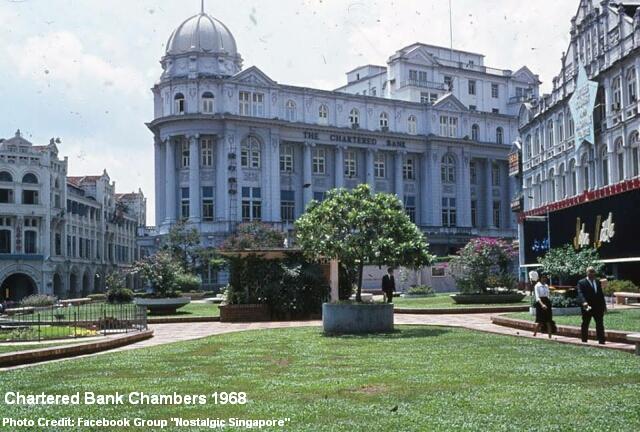
Along with the Mercantile Bank and Hong Kong & Shanghai Bank, the Chartered Bank was one of the earliest foreign banks to be established in Singapore in the mid-19th century. Between 1895 and 1904, the Chartered Bank was located at the corner of Battery Road and Flint Street. It was later shifted nearer to Bonham Street where the bank headquarters continues to operate today.
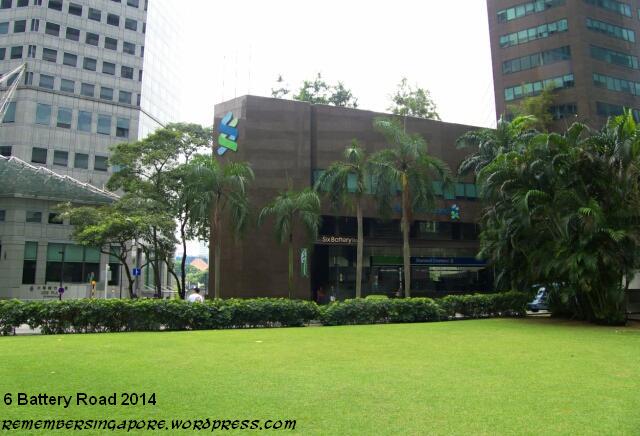
The Chartered Bank Chambers, with its striking dome, was demolished in 1981. In its place, a new Standard Chartered Bank building (known as 6 Battery Road today) was constructed and completed three years later, becoming a new landmark at Raffles Place with its towering 44-storey and 174m-tall design.
Robinsons and John Little
The 114-year-old Robinsons Department Store was another iconic landmark at Raffles Place, having established at Singapore’s prime commercial area since 1858. It survived the Great Depression and the multiple bombings by the Japanese during the Second World War, and even acquired its competitor John Little in 1955. But the great fire on 21 November 1972 ended Robinsons presence at Raffles Place.
The unfortunate disaster, caused by a short circuit, claimed a total of nine life; eight of them perished after being trapped in the lifts. Robinsons also suffered more than $20 million in losses, as its consumer goods packed ready for the coming Christmas period were all destroyed in the burning flames that could be seen as far as Jurong.

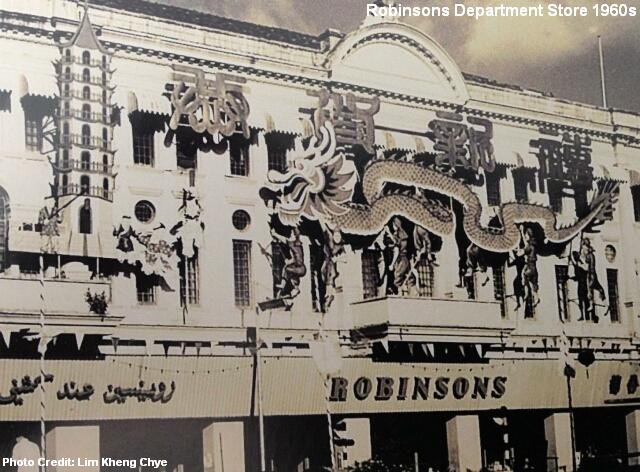
John Little, on the other hand, was established in the mid-19th century. By the 1920s, it had expanded to many major cities in Malaya. During the Second World War, the Japanese forces took over the four-storey signature John Little’s Building at Raffles Place, renaming it as Dimaru to serve the Japanese population in Singapore. After the war, John Little reopened for business and became popular as a “meeting place” for Indian and Chinese merchants from the nearby Market and Malacca Streets.
In 1955, John Little was bought over by Robinsons. Its building, once served as the office for the Singapore Tourist Promotion Board between 1964 and 1970, was torn down in 1973. During the eighties, the oldest department store in Singapore relocated its business to Orchard Road and, later, focused on the smaller retail markets at the heartlands. Its legacy at Raffles Place, however, remained till today as its Spanish-styled facade was used as the design of the entrances for the Raffles Place MRT Station.
Other major department stores such as Oriental Emporium also left, as Raffles Place was transformed into a pure financial centre. The gaps were filled up by other banks, which began to see the rise of the skyscrapers. In 1980, the 190m-tall Shell Tower (Singapore Land Tower today) was built near where John Little used to be, whereas at the former site of Robinsons Department Store, the 63-storey OUB Centre (One Raffles Place today) was completed in 1986 as the tallest building at Raffles Place.
The Alkaff Arcade and the Ocean Building

Well-known as a waterfront landmark at Raffles Place, The Arcade, representative of the Arab influence at the prime commercial belt, was built by the famous Alkaff family in 1909 as Singapore’s first indoor shopping centre. Designed by the Swan and MacLaren Architects, the four-level building possessed a distinctive Moorish style, featuring domes, arches and atrium.
By the seventies, The Alkaff Arcade was bustling with retail and commercial activities even though the building was in bad shape. In 1978, it was demolished and replaced by a new 17-storey retail-and-office tower, after the Alkaffs sold their prized asset to Singapura Developments in the early sixties for $20 million.
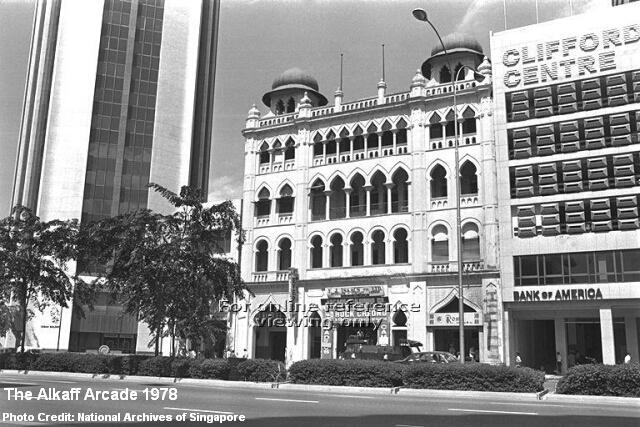
Standing beside The Alkaff Arcade was the Ocean Building. One of the oldest landmarks in Singapore, the first Ocean Building had made its presence at the then Commercial Square since 1864. Its second-generation existed between 1924 and 1970, and was well-known for its popular Prince Restaurant. The third Ocean Building was completed in 1974 in the form of a $70-million 28-storey office and shopping complex. Today, the Ocean Towers and Financial Centre, the fourth generation of its legacy, stand at its place.
Change Alley
Change Alley, a narrow lane between the Winchester House and Singapore Rubber House, was once famous for its money-changers, both legal and illegal, and rows of little retail stores. It had existed for a century as a hotspot of trading activities that involved everything from clothes and bags to toys and souvenirs. During its heydays, visitors had to squeeze their ways through the congested walkways for their bargain-hunting.

The Singapore Rubber House was a 15-storey landmark that faced the Collyer Quay. It was previously known as the Shell House, which started as a five-storey building since 1920. The Winchester House, on the other hand, was built in 1906.
By the late eighties, the businesses at Change Alley had dwindled rapidly due to the decreasing number of foreign sailors and military personnel visiting Singapore. In 1989, the buildings of the Winchester House and Singapore Rubber House were demolished, bringing along with them the permanent closure of the old Change Alley.

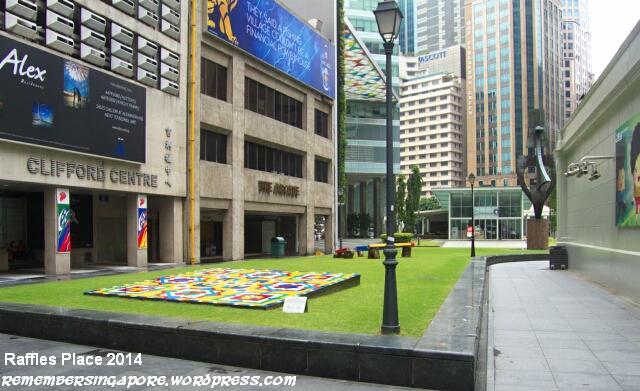
Mercantile Bank Chambers
The magnificent grey building in front of The Arcade was the Mercantile Bank Chambers that stood between two streets of De Souza and D’Almeida. D’Almeida Street is still present today but De Souza Street was absorbed into the Ocean Financial Centre during its redevelopment in the late 2000s. The Mercantile Bank was first established in Singapore as early as 1855 under the name of “Mercantile Bank of India, London, and China”.

The building was later used as the office for the Prudential Assurance Company (1931-1941 and 1945-1962) and the Chartered Bank (1980-1984). In June 1984, the Mercantile Bank Chambers was demolished due to the construction of the Raffles Place MRT Station.
Malayan Bank Chambers
The former body of the Malayan Bank Chambers was the three-storey Whiteaways Laidlaw Building with its popular Whiteaways Department Store. In 1962, the building, then owned by the Malayan Banking Sdn Bhd, was refurbished with a distinctive facade, tapered-in windows and an addition of three storeys. It was torn down in 1999 to make way for the Maybank Building, a new 32-level office tower designed by SYL Architects.
Hong Kong & Shanghai Bank Building
The Hong Kong & Shanghai Bank had its roots in Singapore as early as 1877. It established its first office building at Fullerton Square between 1892 and 1919, before investing in a new Neo-Classical styled tower completed in 1925. The new building lasted more than 50 years until 1979 when it was demolished and replaced three years later by the 21-storey Hong Kong Bank Building (HSBC Building today).
Bank of China Building
Once the tallest landmark at Raffles Place for twenty years between 1954 and 1974, the Bank of China was first set up at Cecil Street in 1936, before moving to its present site at Battery Road in the early fifties. In 1999, its former record-breaking tower was replaced by a new 37-storey Bank of China Building.
Raffles Place Park and Underground Carpark

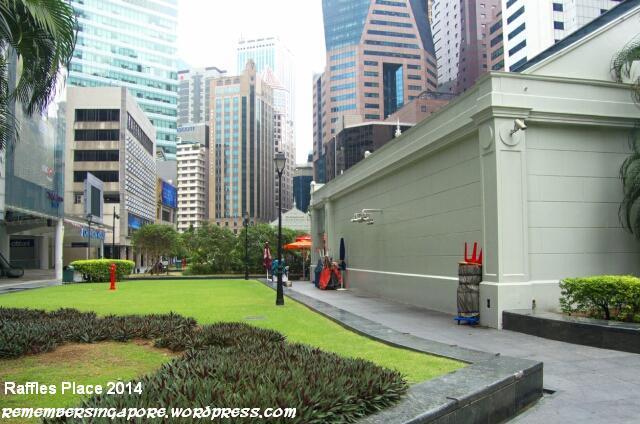
In November 1965, Singapore’s first ever underground carpark at Raffles Place was officially opened by former Prime Minister Lee Kuan Yew. Able to accommodate 250 cars, the new carpark was expected to relive the traffic and parking congesting at Raffles Place, where its previous slots could only cater for 113 vehicles. There was also an underground subway leading directly to the basement of Robinsons Department Store, a feature welcomed by late night shoppers.
Costing a total of $500,000 constructed by the Public Works Department, the underground carpark also featured a rooftop garden known as the Raffles Place Park. Decorated with rows of lawns, shrubs and flower beds, the eye-pleasing popular landscape roof garden also came with ornamental fountains and a giant $58,000 flower clock donated by Japanese watch-maker Seiko.

The underground carpark was demolished in the 1980s due to the construction of the Raffles Place MRT Station.
The 50-Year Chronology of the Prominent Landmarks at Raffles Place:
1962 – The Alkaff Arcade was sold to Singapura Developments for $20 million.
1965 – Singapore’s first large-scaled underground carpark at Raffles Place was officially opened.
1966 – Oriental Emporium opened its department store at Raffles Place.
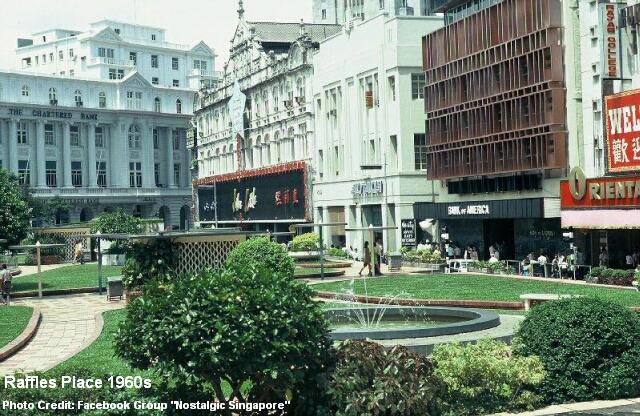
1970 – The Ocean Building was demolished.
1972 – Robinsons Department Store was destroyed in a fire.
1972 – The areas around Raffles Place Park was pedestrianised by the Public Works Department.
1973 – The John Little’s Building was demolished.
1974 – UOB Building (UOB Plaza 2 today) was completed.
1974 – Clifford Centre was completed.
1974 – The Ocean Building was completed as a new third-generation 28-storey office and shopping tower.
1976 – OCBC Centre was completed.
1978 – The Alkaff Arcade was demolished.
1979 – The old Hong Kong & Shanghai Bank Building was demolished.
1980 – Shell Tower (Singapore Land Tower today) was completed.

1981 – The new Arcade was completed.
1981 – The Chartered Bank Building was demolished.
1981 – Prominent waterfront landmark Maritime Building, formerly known as Union Building, was demolished.
1982 – The new Hong Kong Bank Building (HSBC Building today) was completed.
1984 – The Mercantile Bank Chambers was torn down due to the construction of Raffles Place MRT Station.
1984 – The new 44-storey Standard Chartered Bank building (known as 6 Battery Road today) was completed.
1984 – Tung Centre was completed at the former site of Maritime Building.

1986 – OUB Centre (One Raffles Place today) was completed at the former site of Robinson’s Department Store.
1987 – Raffles Place MRT Station was officially opened.
1989 – With the demolition of the Winchester House and Singapore Rubber House, Change Alley was shut down.
1992 – UOB Plaza 1 joined OUB Centre as the tallest buildings at CBD.
1992 – Hitachi Tower was built at the former sites of the Winchester House and Singapore Rubber House.

1995 – The Republic Plaza was the third building at Raffles Place with the height of 280m.
1999 – Malayan Bank Chambers was demolished.
1999 – The new 37-storey Bank of China Building was completed.
2000 – The Fullerton Building, built in 1928, was restored to become The Fullerton Hotel Singapore.
2006 – The 52-year-old Asia Insurance Building was bought over by the Ascott Group for $110 million, and renamed as Ascott Singapore.
2007 – The third-generation Ocean Building was demolished.
2011 – The Ocean Towers and Financial Centre was completed.
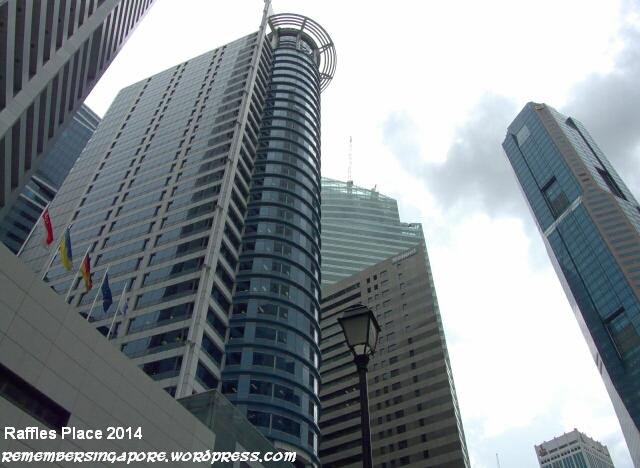
The Tallest Landmarks at Raffles Place:
1954 – Bank of China Building (18-storey, 87m tall)
1955 – Asia Insurance Building (Ascott Singapore today) (18-storey, 87m tall)
1974 – UOB Building (UOB Plaza 2 today) (38-storey, 162m tall)
1976 – OCBC Centre (52-storey, 198m tall)
1986 – OUB Centre (One Raffles Place today) (63-storey, 280m tall)
1992 – UOB Plaza 1 (66-storey, 280m tall)
1995 – Republic Plaza (66-storey, 280m tall)
Published: 28 July 2014
Updated: 06 August 2014








Really enjoyed your article on raffles place. I worked at the Frisco Restaurant at the basement of the Hongkong bank in the early 80s and spent many hours strolling around the area during my split shifts. Will always remember the food centre by the river near the standard chartered buiding and boats and tongkangs would be seen plying while tucking and enjoying our noodles.
Hi Dominic I used to dine at the FRISCO in the 80’s. Fine restaurant indeed. Wow…goes back a long long time man !
Patrick Choo Spore
Hi Patrick, great to hear from you. Indeed a long time ago. It may interest you and others to note that during that period, we had quite a good number of restaurants and coffee houses around the Raffles Place area. We may be in competition but all of us maintained a good and friendly relationship with one another even to the extent of helping out and loaning our cutlery and other necessary items to each other whenever we had a big event or catering. See if you remember these names or may have dined at as well.
Stamford Arms
Restaurant 1819
Cherry Restaurant
Café Arcadia
The Beluga
Le Bernadine
Marie Chantel Restaurant
Troika (basement of Clifford Centre)
Troika (new management at Keck Seng Tower Cecil St )
Wonderful article, thank you for all the historic info and pictures! I remember the Raffles Place of 1990 🙂
Thanks author for all of your hardwork….. without them i dun even know some of this building existed in raffles. Its rather pity that P*P Garment prefer profit rather than coming up ways to preserve our Singapore long lost building. 10 years from now all of our pioneer hard effort will be gone in the drain.
Can I ask a nerdy question about the Mercantile Bank building? In 1916, the Mercantile Bank (did you know it was the oldest bank in Malaysia and I think maybe the first in Singapore – 1856?) bought a lease on the earlier building that occupied this site, 21 Raffles Place. The building you illustrate was put up in 1930, constructed of reinforced concrete. Upstairs, above the bank, some 30 rooms of bank ‘chambers’ were rented out as offices. I think the architects were Swan & Maclaren, who did most of the other spiffy buildings in Sg at that time. The Mercantile was taken over by the Hongkong Bank (HSBC) in 1959, but continued independently until finally the two were integrated around 1973. So my question is: when you say that it was the office for the Prudential Assurance Company (1931-1941 and 1945-1962), did they operate in another part of the building? The Mercantile must have been carrying on there. The Chartered Bank (1980-1984) – was that Standard Chartered, whose office was at the other end of Raffles Place? Their old building was demolished in 1981, so I guess they may have moved temporarily down the other end of Raffles Place while Six Battery Road was being built. Someone reading this will know. Thanks for a great blog.
Replying to myself, I just read a report published in the Straits Times at the time that the architect was one Somers H. Ellis (whether or not working for Swan & Maclaren I don’t know); but shortly afterwards Ellis wrote to the newspaper saying that ‘the architects responsible for the elevation and architectural details were Messrs Briggs and Thornely of Liverpool, “to whom credit is due for the admirable effect achieved.”
Aaaarrrgh – disregard the above – I was talking about the Ocean Building.
I joined The Chartered Bank at Battery Road on January 1975. It was renamed the Standard Chartered Bank in the 1980s when The Chartered Bank merged with Standard Bank. We shifted to Mercantile Bank Chambers temporarily when the beautiful old colonial building was demolished to make way for the present new building. Both the old Chartered Bank Chambers and the Mercantile Bank Chambers were really beautiful buildings with great architectural values. I still miss them today. I was wondering why the government did not conserve them. Sigh!
Yes the Chartered Bank building was beautiful and would have looked as magnificent as the Fullerton Hotel today if it was conserved. I think back in those days, people were less educated and more concerned with basic necessities like food and shelter. Heritage conservation would have been the furthest on their minds.
Aiyo why demolish the charted bank chamber, such a beautiful building 😦
Amazing blog. Thanks for all the wonderful pictures and factoids about old Singapore: it must have taken ages to amass all this. 🙂
Another view of the beautiful Chartered Bank, and John Little store by its side. The Bank of China building was in the background.
The year was 1971.
(Photo credit: https://www.flickr.com/photos/87791108@N00/sets/72057594116286850)
Reblogged this on old world underground and commented:
This is so amazing. Raffles Place 50 years ago!
Thanks for sharing the fond nostalgic memories of Raffles Place on this blog. Very thoroughly researched from many resources and posted the “memory aid” old photos to juxtapose the then and now at Raffles Place. Well done! Please keep up the great job!
I wished that they didn’t tore down so many beautiful architectures in Raffles Place!
Great posting. Same feelings too, well, this is Singapore CBD area where the real estate prices have gone bananas. Buildings will come and go. I am sure in another 50 years time, new buildings would have replaced existing one.
Thanks for the wonderful photos and postings. Does anyone remember the site of USIS(United States Information Service). I believed it was near on the same side as Robinson Department Store. I and many people used to frequent the place, specially during lunch period, one can picked up an array of propaganda literatures(even taking it home for free) and read in the comfort of sofa and air-conditioning(some people even napping in there!).
David Chung
USIS – It was on the John Little Department side where the Pan Am airlines and Air India office was.The building was where now the Singapore Land Tower stands and next to Caltex House. EDB Singapore office moved in after space was available in that building
Beautiful facades that could have been kept, but lest we forget, no airconditioning small cluttered rooms old elevators and no space …… tower blocks provide a great workspace and room for other outdoor activities.
More photos of Raffles Place in the 1960s….
The Open-air Carpark
Finlayson Green Park
Robinsons Department Store
(Source: Facebook Group “Nostalgic Singapore”)
Am I the only one who feels sad and angry that such beautiful colonial buildings were torn down in the name of progress and development? The buildings are so beautiful, that represented Singapore’s history, buildings that can’t be replaced meaningfully, forever gone because they were standing in the way of corporate and political greed. If only they were retained like the heritage precincts you see overseas, these areas could have been revitalised into tourism centres highlighting Singapore’s history. Public places of parks, restaurants, museums, galleries, cafes, hotels, high end retail, arts, performance centres, public speaking squares, full of festivals, baskers, markets, street art, ideas, people, tourists. But no, today just tall soulless private closed off buildings of towering glass and steel, each one no different to the next. Only occupied by rats running the race, and devoid of life after dark, and most of the day really.
The present-day facade of the exit building of Raffles Place MRT Station is modeled after the iconic John Little department store
(Photo Credit: The Straits Times)
I was in Changi in 1965 with the W.R.A.F. and still have a Chartered bank book with 5 dollars in it.
Wonder if it’s worth anything today.
S$5 may buy you a bowl of noodles in most Food Courts or Hawker Center!
Mind you does your banknote is still in legal tender as most old money had been redundant!
They should have not demolished every building! At least keep the front facade. They can still have their sky scraper behind just the front farcade wall entrance for memory sake. Look at the old Standard Chartered building, at least they could have saved the Dome area. Why had the not think of that? National Theater is a good example and the list goes on.
A change for Change Alley…
Change Alley Mall renamed CIMB Plaza after bank relocates
2 June 2022
Channel NewsAsia
Change Alley Mall at Raffles Place has been renamed CIMB Plaza after the Malaysian bank officially opened its new offices above the premises on Wednesday (Jun 1).
“CIMB Singapore is proud to be part of this rich history, and owning the naming rights of CIMB Plaza will further solidify CIMB’s footprint in Singapore,” said the bank in a news release.
An iconic landmark in Singapore’s central business district, Change Alley was thought to be named in 1890 after a trading hub called Exchange Alley in London. It was known to be a thriving market where the likes of moneychangers as well as gambier and pepper traders gather to do business.
Before moving to 30 Raffles Place last December, CIMB Singapore had been at Singapore Land Tower for 12 years. In a speech at the naming ceremony on Wednesday, CIMB Singapore CEO Victor Lee said that the shift gave them the opportunity to build an office that is “adapted to the future of work”.
“A world of new normal of flexible work arrangements, of hot desking and co-working space, the need for agility and teams to collaborate more intimately,” he said.
CIMB Singapore has about 1,000 employees located at two offices premises, one at 30 Raffles Place and the other at Changi Business Park. It previously shut its branch in Orchard Road following a review of its business and resources.
CIMB said: “In designing our new office, we factored in hybrid workplace requirements to cater to work-from-home and work-in-office, leveraging on our digitalisation capabilities.
“We wanted to take advantage of moving into a Green Mark-certified building to develop an open concept workspace that was clean, safe and sustainable.”
https://www.channelnewsasia.com/singapore/change-alley-mall-rename-cimb-plaza-bank-relocates-2722361
It has been a long while since I last received your current posting. Looking at the many old photos of past brings back much treasured memory for us the elderlies! Thanks very much and hope more articles and photos to enlighten your readers!
David
Sent from Mail for Windows
Singapore’s tallest skyscraper to be built by Alibaba and local partners
5 August 2022
Channel NewsAsia
Chinese Internet giant Alibaba and a consortium led by Singapore-based real estate company Perennial Holdings have obtained approval for plans to build a 63-storey mixed-use development at Shenton Way in the Central Business District.
With a maximum approved height of 305m as seen in Urban Redevelopment Authority (URA) documents, the building could overtake the 284m-tall Guoco Tower as the tallest building in Singapore.
A URA spokesperson said on Friday (Aug 5) that the approved building height of 305m at 8 Shenton Way is the highest granted by the authority for developments in Singapore.
“The allowable building heights are subject to technical requirements as well as evaluation based on respective site context,” she said. “Developments would have to be built in accordance to the approved plans and guidelines.”
The new development will be built on the site currently occupied by a 50-storey building, formerly known as AXA Tower, at 8 Shenton Way in Tanjong Pagar.
The site first hosted the Treasury Building in 1986, which was previously the headquarters of state investment firm Temasek Holdings.
When completed, the Alibaba-backed project could join Guoco Tower as the only buildings in Singapore to exceed 280m in height.
The building is set to be completed by 2028, reported Forbes.
https://www.channelnewsasia.com/business/singapore-tallest-building-alibaba-perennial-axa-tower-guoco-2860921